In the modern age of retail marketing, the adoption of Customer Data Platforms (CDPs) has witnessed a remarkable surge, with a notable $2.3 billion in revenue generated in 2023—an upward trajectory expected to persist. As businesses increasingly recognize the pivotal role of personalized marketing in meeting customer expectations, the imperative to invest in CDPs has become more pronounced. These platforms serve as the linchpin, seamlessly integrating diverse digital channels and vast volumes of customer data into a unified, comprehensible repository. Navigating this guide will empower readers with insights into the transformative benefits of CDPs that await. Moreover, this blog post will unveil the burgeoning statistics underpinning CDP adoption, promising an efficient approach that will revolutionize every retailer’s marketing strategies.
Table of Contents
- > What is a customer data platform?
- > Why is a CDP important for a retail business?
- > The evolution of data management in retail
- > Understanding the basics of CDPs: The key ingredients
- > The technological anatomy of a CDP
- > Data collection and CDPs
- > The role of CDPs in modern retail
- > Omnichannel strategies and CDPs
- > Actual CDP case studies: Successful omnichannel use cases
- > Customer retention and loyalty
- > Marketing automation and CDPs: How ContactPigeon’s CDP can help retailers
- > Important CDP statistics
- > Latest trends around CDPs in retail
- > Conclusion: A CDP is a must for any retailer in 2024
What is a customer data platform?
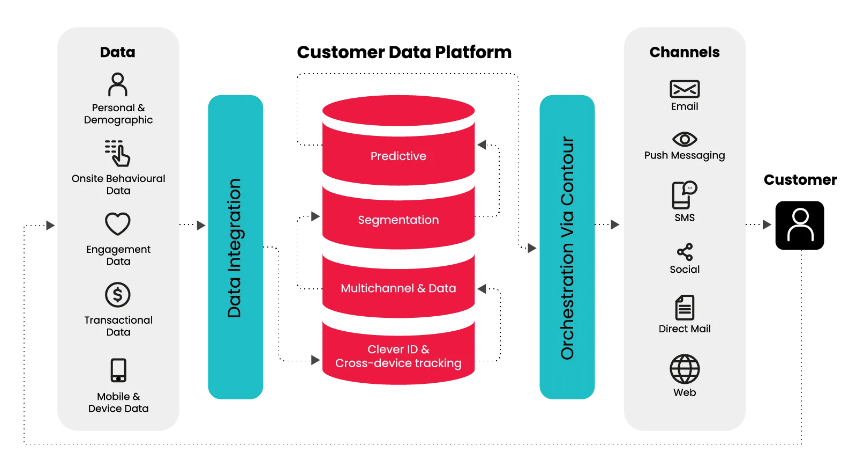
A customer data platform is a software solution that unifies customer data from multiple locations. In a single environment containing all the available data on file, retailers get a complete view of each customer, allowing them to develop highly targeted marketing campaigns and tailored shopping experiences.
Why is a CDP important for a retail business?
With more retailers opting for an omnichannel approach to service delivery, they’re reaching customers in more locations. A CDP allows retailers to deliver personalized service to each customer based on multiple sources of data. Many of these platforms also offer marketing and customer service automation, which enhances the customer experience. Retailers can use these tools to personalize their relationships with customers and stand out from the competition.
The evolution of data management in retail
Retailers have been using customer data to improve service delivery since the beginning of the 20th century. In the early days, they used a combination of customer surveys, on-site observations, interviews, and analyses of physical records. Of course, data collection and storage methods have vastly improved since the days of paper ledgers and boxes upon boxes of receipts:
- 1980s: Universal product codes (UPCs) and other technologies allow retailers to track shopping patterns and popular products.
- 1980s: American Airlines introduces its AAdvantage loyalty program to reward frequent flyers. Other businesses eventually follow suit.
- Early 1990s: Walmart prototypes a computerized data warehouse chronicling inventory and sales data.
- 1994: Tracking cookies are invented.
- Late 1990s: More retailers begin using computers and the internet to collect and store sales and inventory information and customer data.
- Mid-2000s: Large retailers start analyzing customer shopping patterns and other types of data to guide their business decisions.
- 2010s: New technology allows retailers to reach customers using an omnichannel model through physical locations, online shopping, and smartphone apps.
- 2016: The European Union passes the General Data Protection Regulation (GDPR), a sweeping set of rules aimed at protecting consumer data.
- 2018: California passes the California Consumer Privacy Act (CCPA) intending to protect consumer data.
- Early 2020s: As data privacy concerns lead governments to regulate consumer data collection, Google decides to phase out third-party cookies.
Understanding the basics of CDPs: The key ingredients

Customer data platforms unify data in one location, making it easier to tailor marketing campaigns and design a seamless user experience.
Core components of a CDP
Different CDPs offer different features. Some focus on a specific area, such as marketing and segmentation. Others provide more robust platforms and systems. Some of the most common components include the following features:
- Unified customer ID: a unique identifier that can identify all first-party, third-party, and zero-party data on a single customer
- Customer segmentation: a feature that allows retailers to identify similarities in their customers to group them appropriately
- Analysis and recommendations: a feature that analyzes customer data to find insights
- Reporting: a tool that synthesizes the analysis into an easily digestible report
- Activation: automated marketing solutions that retailers can use to act on their reports
Differences between CDP vs. CRM vs. DMP
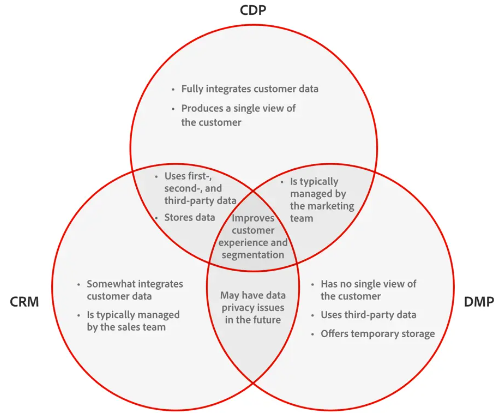
A CDP is not necessarily interchangeable with a client relationship management (CRM) platform or a data management platform (DMP). Each of these tools may overlap, but they are used for different reasons.
- CRM software can manage customer relationships at every step of the buyer journey. A retailer may use CRM software to manage its marketing messaging, creating a cohesive journey across each customer touchpoint to generate sales and build brand loyalty.
- A CDP is used to track how customers behave with each organization. These platforms collect a variety of data, including personally identifiable information (PII), from multiple sources to help retailers understand how people are interacting with their brands. This data offers insights into a retailer’s best marketing channels and helps it develop targeted marketing strategies.
- A DMP is similar to a CDP; however, DMP software collects only anonymized data. DMPs can also track data from within the company. Many retailers use DMP tools to direct their media buys and ad placements.
Tip: You can read our detailed guide about CDP and CRM synergies here
The technological anatomy of a CDP
CDPs allow marketers to collect and analyze high volumes of data, and these tools are improving with advancements in technology. Each customer data platform in the retail framework has the following elements.
Data integration: The heart of the CDP
Data integration is the practice of categorizing and organizing data from multiple sources. CDP software combines information from CRM platforms, social media and website analytics, third-party tracking software, in-store purchases, and other sources to offer a 360-degree view of each customer.
Data processing and management: The brain of the CDP
After assembling data from multiple sources, the CDP processes each piece of data. It standardizes information from multiple sources by matching customer identifiers and combining the data into a single profile. It then classifies each customer profile.
User interface: The face of the CDP
Data means nothing without context. A CDP offers a user interface that allows retail marketers to analyze and interpret the data. Many offer drag-and-drop features and other tools that marketers can use to import spreadsheets and generate reports. Most CDPs also offer custom dashboards that allow marketers to easily spot the customer insights that matter most to them.
Data collection and CDPs
Retailers have collected customer data for more than a century. While they were once limited to tracking customers in a store using a journal or sign-in book, today’s retailers have access to more data than they can handle alone.
Sources of customer data for retailers
Common sources of customer data include third-party tracking software, social media, point-of-sale systems, website sign-up lists, email lists, customer surveys, customer service feedback, and industry reports.
Ensuring data quality and consistency
To work well, a CDP needs quality data. Before entering data into their CDP, retailers should check for duplicates or overlapping data, check for mandatory fields, and look for missing data. Cleaning data makes the CDP reporting tools more accurate.
Privacy and compliance in data collection
In the past five years, data privacy has become a major concern, and retailers are limited on what kinds of data they can collect and how they can use it. Along with Google phasing out tracking cookies, retailers need to establish clear privacy policies and give all customers a way to opt out of data collection and remove themselves from existing lists.
Combining AI and Machine Learning (ML)
Like other types of business analytics software, many CDPs are starting to use artificial intelligence and machine learning to speed up their processes. AI and machine learning can identify trends and patterns that help retailers anticipate customers’ needs and personalize their experience.
Predictive analytics in retail
Predictive analytics use historical data to make assumptions about future consumer behaviors. Retailers can use this information to manage their inventory, guide their sales and promotions, and develop targeted marketing strategies, among other uses.
Turning data into actionable insights
CDP reporting and analytics tools compile data and offer useful insights for retailers and marketers alike. With these tools, retailers can use key performance indicators to inform their marketing and service delivery strategy. They can spot patterns to identify potential opportunities and find better solutions to their current challenges. Finally, they can use all of their CDP data to create a more rewarding experience for customers by better understanding and responding to their needs.

The role of CDPs in modern retail
As more retailers compete with one another for consumers’ attention, CDP solutions will allow them to stand out and build better relationships with existing and potential customers.
Personalization and customer experience
CDPs allow retailers to optimize the online and in-person experiences for their customers based on historical information. Retailers who know how to nail personalization generate 40% more revenue from these efforts.
Personalization includes targeting and retargeting based on how a customer interacts with a website. For example, if a customer stays on a product page for a long time, they could see a chatbot pop-up offering to answer any questions they might have. Or they could log in to a retailer’s website and see personalized product recommendations based on their shopping history.
Crafting individualized customer journeys using CDP
Instead of using a generic customer journey map to plan promotion strategies, retailers can use CDPs to appeal to individual users. With data-driven insights, they can more precisely target customers at different stages and moments of their journey in the most effective locations. For example, instead of launching a broad-based social media campaign, retailers can specifically target their customers on social media with personalized messages.
Omnichannel strategies and CDPs
Online shopping might be popular, but it’s not the only way in which customers interact with retailers. Many customers still shop at brick-and-mortar stores, and retailers need to collect information from both places to create a cohesive omnichannel experience.
Unifying online and offline customer data
Retailers can integrate offline data into their CDPs using unique identifying information. If a retailer collects a customer’s email address or phone number at the point of sale or on a customer service call, they can enter the data into the CDP to determine whether the customer has also shopped online. Unifying online and offline data gives retailers a more complete picture of each customer and serves as a guide for impactful marketing strategies.
Creating a seamless omnichannel experience
With the right CDP, retailers can create a seamless experience for each customer. They can develop targeted, personalized marketing campaigns to draw customers to their websites or stores. Existing customers can earn and use their loyalty points in the store and online as they see fit.
Customers who shop online can return items to a physical location or have their purchase shipped to a store for easier pickup. CDPs make all of this possible, serving as a single source for all customer data. For example, if a customer is trying to pick up their order at their local store, they can be sure the in-store staff will have a record of their online purchase.
Actual CDP case studies: Successful omnichannel use cases
Here are some real-life examples of companies in the retail space successfully leveraging CDP data. Take a look and get inspired by industry giants.
CDP Case Study #1: Shiseido

Challenge: Shiseido, a global beauty brand, needed to optimize marketing spend across 120 countries. Traditional methods lacked the granularity to target high-value customers effectively.
Solution: Shiseido leveraged Customer Data Platform (CDP) technology and AI to:
- Unify Customer Data: Integrate data from various sources (sales, loyalty programs) for a holistic customer view.
- Predict Customer Lifetime Value (CLTV): Develop AI models to identify high-value customers with long-term purchase potential.
- Segment Customers: Group customers based on predicted CLTV (low vs. high).
- Tailored Messaging: Craft marketing campaigns with messaging relevant to each customer segment’s needs and preferences.
Results:
- 12.6% Revenue Increase: Shiseido’s targeted marketing strategy significantly boosted revenue.
- Improved Marketing ROI: Focusing on high-value customers maximized the return on marketing investments.
Key Learnings for Retail Executives:
- Data is Power: Unify customer data across channels to gain a 360-degree customer view.
- AI Can Predict Value: Leverage AI to identify high-value customers and personalize marketing efforts.
- Segmentation is Key: Group customers by predicted CLTV to tailor messaging and maximize impact.
- Focus on High-Value Customers: Prioritize marketing spend towards customers with a strong potential for long-term loyalty and revenue generation.
CDP Case Study #2: Nike
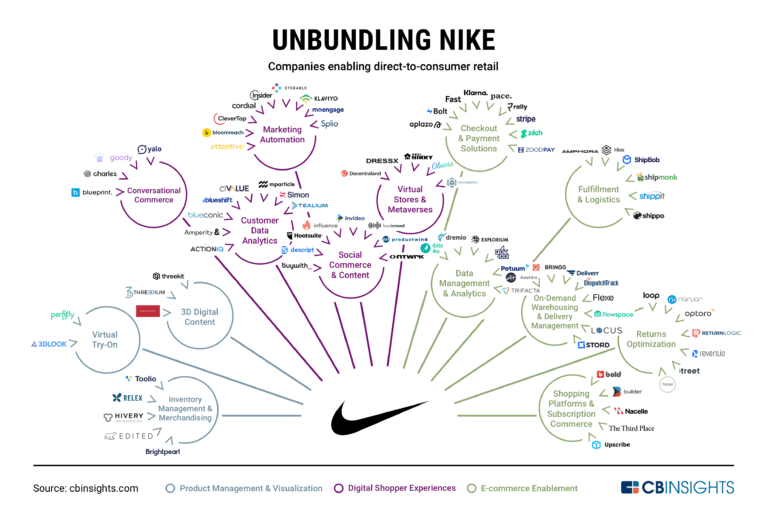
Challenge: Nike, a leader in direct-to-consumer (D2C) sales, sought to elevate customer experiences and drive sales further.
Solution: Ditching generic advertising, Nike harnessed a Customer Data Platform (CDP) to:
- Unify Customer Data: Consolidate data from various sources (purchases, app interactions) for a holistic customer view.
- Actionable Insights: Analyze data to understand individual customer preferences and behavior.
- Personalization Powerhouse: The CDP fuels Nike’s personalization efforts across the customer journey:
- Targeted Promotions: Recommend products based on past purchases and browsing activity.
- Smart Inventory: Optimize stock levels based on predicted customer demand, reducing stockouts and overstocking.
- Dynamic Displays: Tailor product recommendations and store layouts for individual customers, maximizing in-store engagement.
Results: Nike’s data-driven approach pays off:
- D2C Dominance: In 2021, a staggering 39% of Nike’s revenue came from direct-to-consumer sales.
Key Learnings for Retail Executives:
- Personalization is Profitable: Prioritize personalized experiences to keep customers engaged and drive sales.
- Unlock Customer Insights: A CDP empowers you to truly understand your customer base.
- Target the Right Audience: Focus marketing efforts on high-potential customers for maximum impact.
- Data-Driven Decisions: Leverage customer data to optimize inventory and store displays.
CDP Case Study #3: Target
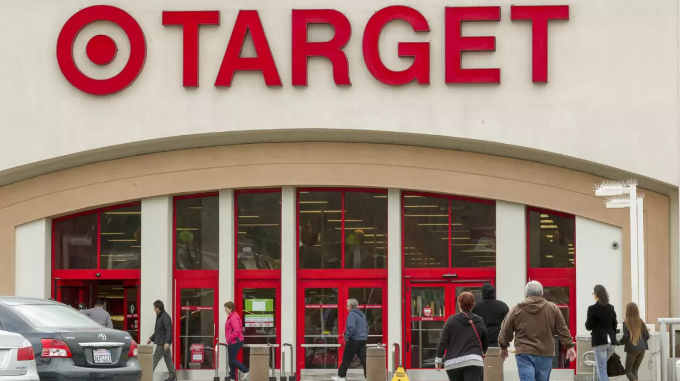
Challenge: Target strives to deliver a frictionless and consistent shopping experience across online and physical stores.
Solution: Target utilizes a Customer Data Platform (CDP) to:
- Consolidate Customer Data: Gather data from various sources like customer satisfaction surveys, Circle Rewards program, online accounts, and more.
- Unify Customer View: Create a holistic profile for each customer, encompassing online and offline interactions.
Results: Target’s data-driven approach yields positive results:
- Happy Customers: Personalized experiences keep customers engaged and foster loyalty.
Key Learnings for Retail Executives:
- Data is the Foundation: Build a strong foundation by unifying customer data from all touchpoints using a CDP.
- Personalization is Key: Prioritize creating personalized experiences to boost customer satisfaction and loyalty.
- Bridge the Online-Offline Divide: Unify online and offline data to ensure a seamless shopping journey.
- Data-Driven Decisions: Leverage customer insights to make informed business decisions.
Customer retention and loyalty
For retailers, a CDP isn’t just good for attracting customers; it’s also a great resource for encouraging them to stay with the brand ensuring lifetime value.
Using a CDP to enhance customer loyalty
With CDP insights on each customer, a retailer can create a more personalized experience, engaging customers on their preferred platforms and giving them tailored offers. Retailers can also target customers with messages that clearly address their specific pain points, inspiring future purchases and loyalty.
Example Ideas for Retailers:
- Target offers, discounts, and loyalty programs based on individual purchase history, preferences, and behaviors
- Use CDP data to orchestrate personalized communications across email, SMS, social media, and in-app notifications.
- Identify and address potential customer issues before they escalate with proactive support and outreach facilitated by CDP-powered insights
- Offer exclusive content, early access to sales, or invitations to special events based on customer interests and loyalty status
- Gather and analyze customer feedback and use it to continuously improve products, services, and the overall customer experience
Identifying and retaining high-value customers using a CDP
Like Shiseido, retailers can use CDPs to identify their best customers and develop strategies for improving their brand loyalty. Once they’ve identified their best customers, retailers can offer a unique experience and engage with them in dialogue to improve their products and services. Retailers can target these customers with product launches and offer them the chance to be the first to experience something new.
Example Ideas for Retailers:
- Create customer segments based on a combination of purchase history (e.g., order frequency, average order value), demographics, engagement metrics (e.g., email open rates), and behavioral data
- Customize product recommendations, promotions, and content specifically for your high-value customers
- Create tiered loyalty programs with exclusive rewards and benefits for top-tier customers.
Designing next-gen, CDP-driven loyalty programs
Instead of creating a loyalty program that offers the same benefits to each member, retailers can use CDPs to tailor their loyalty programs based on customers’ preferences. A retailer such as Sephora, for example, may have targeted only women in the past, offering freebies based on its best-selling products. However, CDP data may show Sephora that its customer base consists of people of all genders with a variety of beauty needs. With this data, the company can offer personalized loyalty rewards based on a customer’s past purchases. Personalized reward programs offer more value to customers.
Example Ideas for Retailers:
- Create a seamless earning and redemption experience across all channels – website, mobile app, in-store
- Use CDP insights to reward behaviors that drive value (social sharing, reviews, referrals).
- Incorporate elements of fun and competition (badges, leaderboards) fueled by CDP data.
- Offer birthday points, surprise rewards based on browsing behavior, or trigger-based bonuses to enhance the feeling of “delight”
- Offer tiered benefits, exclusive experiences, and early access
Marketing automation and CDPs: How ContactPigeon’s CDP can help retailers

ContactPigeon offers unique customer insights to retailers based on first-party data from their own customers. ContactPigeon’s CDP can build a single customer profile from integrated data across marketing channels.
Retailers can use these insights, along with user-friendly analytics and dashboards, to automate their omnichannel customer engagement strategy. Data from these customer profiles informs retargeting, personalized offers, upselling, and more to maximize a customer’s lifetime value. Learn more about how it works by scheduling a demo.
What’s Different about it:
- Built for retailers
- RFM and ML-based clustering of customers
- No more data silos
- Easy but Powerful UI
- Supports custom alerts
Read more about our new Customer Data Platform capabilities here
Important CDP statistics
- There are currently 77 worldwide CDP vendors (Statista).
- Almost 50% of businesses expect the end of third-party cookies to negatively impact their marketing ROI (Lytics).
- CDP revenue in 2023 grew by 15% over the previous year (Statista).
- 71% of CIOs say they can tie revenue growth to real-time data (DataStax).
- 87% of marketers expected to increase how much they spend on technology in 2022 (AList).
- 91% of businesses are planning to adopt CDPs as a response to data privacy regulations (AList).
Latest trends around CDPs in retail
- Marketers are more interested in prebuilt CDPs than custom-built platforms (CX Today).
- More retailers are turning to automation to deal with workforce shortages (Forrester).
- Customers continue to expect personalization, making CDPs vital (Adobe).
- 71% of retailers state that it’s hard to track offline activity, which is easier with a CDP (Adobe).
Conclusion: A CDP is a must for any retailer in 2024
The retail industry is always shifting. In 2024, as more companies tackle data privacy regulations, they’ll need to adapt their marketing strategies. Understanding what a CDP is helps retailers maximize their marketing and customer service efforts. Choosing a robust CDP can help retailers bridge the data gap by creating highly detailed user profiles to deliver personalized experiences and marketing campaigns without violating customers’ privacy. Retailers that use CDPs can stand out from their competitors with detailed targeting and segmentation. In 2024, a CDP will not be a luxury; it’ll be a marketing necessity.

Let’s Help You Scale Up


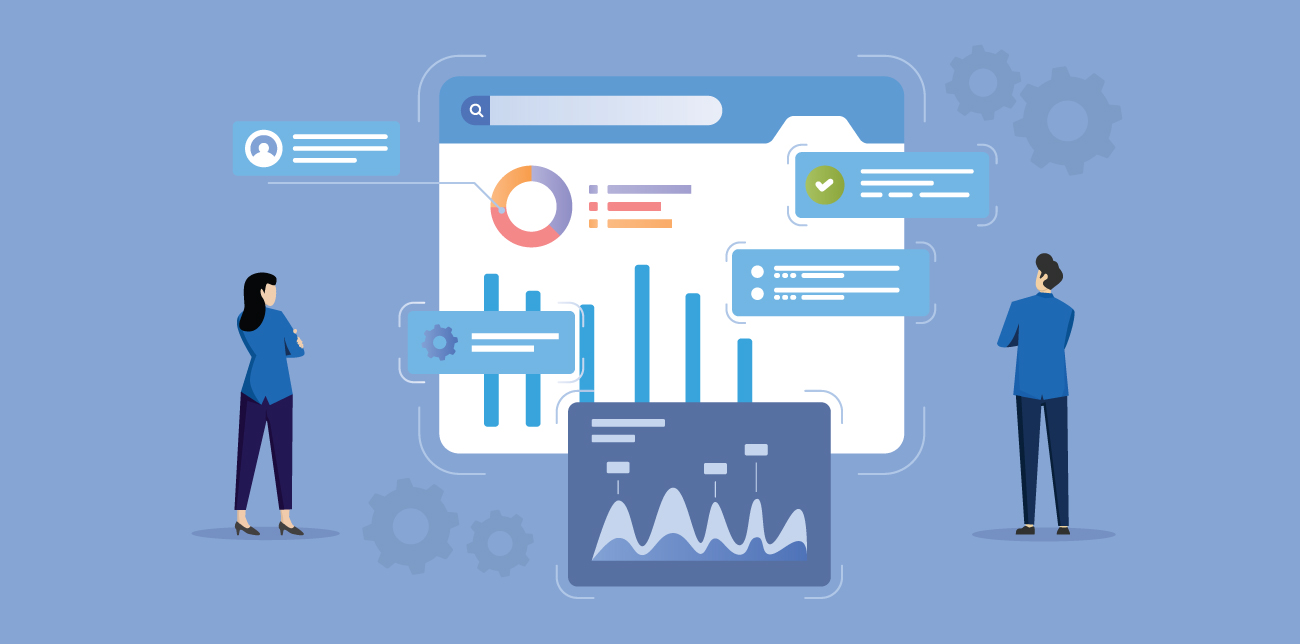

![Benchmarking Growth Strategies of Top Fashion Retailers [Study]](https://blog.contactpigeon.com/wp-content/uploads/2025/11/top-fashion-retailers.jpg)